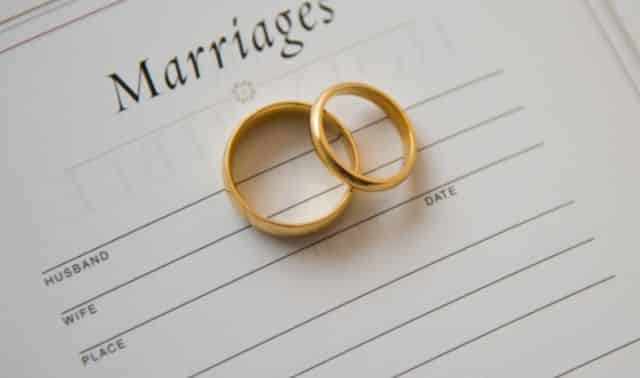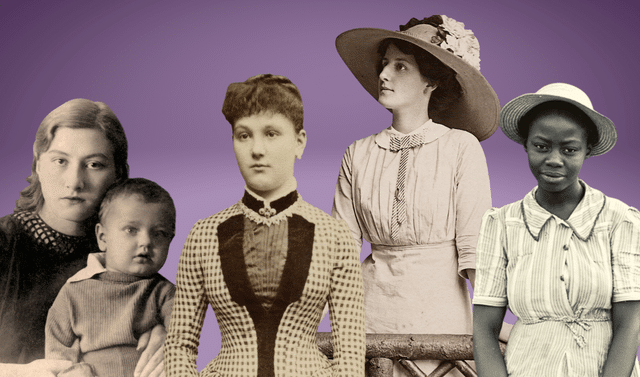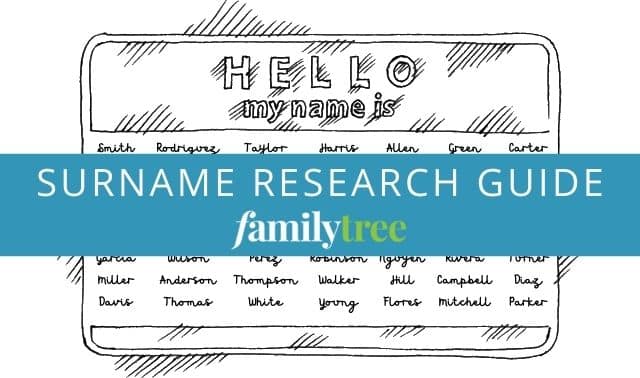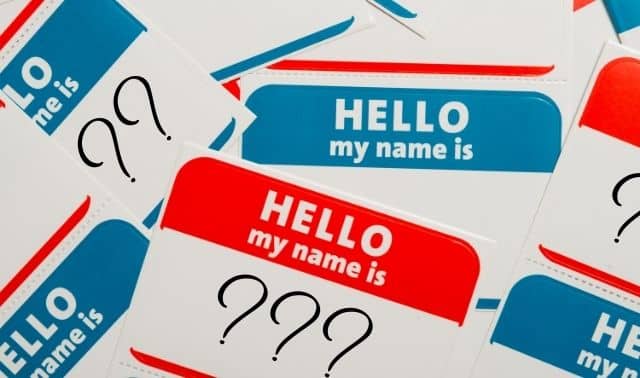Sign up for the Family Tree Newsletter Plus, you’ll receive our 10 Essential Genealogy Research Forms PDF as a special thank you!
Get Your Free Genealogy Forms
"*" indicates required fields

Every family historian has at least one: a female ancestor whose maiden name—the key to unlocking previous generations—you just can’t find. Especially prior to the 20th century, finding foremothers is complicated by the fact that women changed their names at marriage, didn’t often own property and generally left fewer historical records than men. The documents you do turn up might list Great-great-grandma simply as Mrs. So-and-so. Without at least a father’s name, your “maiden voyage” may hit rough waters.
Never fear: We’ve laid out a treasure map of 10 places to look for keys to your female ancestor’s past. Recovering a lady’s maiden name requires a little exploration, so let’s begin with the most easily accessible records first.
1. Marriage Records
The most obvious place to find a maiden name is a marriage record. Depending when and where the wedding happened, a marriage license (and the compiled indexes of marriage records) might show only the bride and groom’s names, and the marriage date and location. The marriage application or marriage return, however, could include many more details: birthplace and date, parents’ names and birthplaces, occupation, place of residence, number of previous marriages, previous married name and mental condition (for example, “feeble-minded” or “epileptic”).
These documents are usually at the county clerk’s office. A good place to start looking for marriage records is the Family History Library. Do a keyword search on marriage records and the location. You can borrow any microfilms you find through your local Family History Center (FHC). Find one near you here.
Note: FamilySearch has discontinued the library’s microfilm distribution services. Find more information here.
You might find more details in marriage banns or bonds. A bann is an announcement of a planned marriage, offering the public an opportunity to make any objections on legal grounds (such as another spouse in the next town). Banns were posted in the home churches of the prospective bride and groom for three consecutive Sundays. If no one objected, the couple was free to marry.
A prospective groom would take out a marriage bond in the court of the bride’s home county to declare he was free from any legal entanglement that would prevent the marriage. As a tool for finding maiden names, bonds are hit-or-miss: Some give the wedding location and date, and name the bride and groom, plus any witnesses or bondsmen (sometimes the father, uncle or another relative of the bride). I’ve also seen bonds that name the groom and bondsman, and neglect to name the bride at all. But it’s worth checking to see if you get lucky. Look in local libraries for marriage banns from area churches—many have been collected and published. Marriage bonds, if required, were filed at the county courthouse.
2. Bible Records
The holy grail of genealogy is a family Bible dutifully filled with lists of births, deaths and marriages. Before the start of official vital records, a Bible is sometimes the only record tying one generation to another. Of course, Bible records are only as accurate as the person writing down the information. For example, it wasn’t unheard of for marriage and birth dates to be manipulated slightly to ensure a nine-month interval between them.
The Bible’s publication date also can raise questions about the authenticity of the family record. If the Bible was published after most of the births, marriages and deaths inscribed therein, the person who recorded the information probably wasn’t working from firsthand knowledge. You also can date Bible entries by the type of pen or ink used—for example, ballpoint pens didn’t come into common use until after World War II; felt-tip pens first became popular in the 1960s.
If family lore says someone has the venerable family Bible, now is a good time to contact all of those far-flung cousins. And check with local genealogical libraries to see if they have any local family Bible records that might be pertinent.
3. Obituaries
Newspaper obituaries usually list the maiden name of a married woman, her birthplace and sometimes the names of her parents. A detailed obituary of a prominent citizen may name the pallbearers, the clergyman who performed the funeral service and even the organist.
If you know what city the person died in, begin with the website of that city’s major newspaper. Many sites have an archive feature containing at least the most recent obituaries, and often all of the obituaries that have appeared online. If the date you’re searching for is pre-internet, contact the newspaper to find out how to research back issues.
To find an older obituary, you first need to find out what newspapers were published in your particular target area, when they were published and whether they had daily or weekly editions. The local library and local or state historical society will have this information, and may even have microfilmed back issues on site to research. Online resources such as ProQuest Obituaries are available through subscribing libraries. Subscription sites GenealogyBank and Ancestry.com both boast substantial obituary collections.
You can focus your search by considering how often the newspaper was published. In a daily paper, obituaries usually appeared one or two days after a person’s death. In a weekly newspaper, especially in the days when news traveled by post, news of a death could take several weeks to appear in print.
4. Vital Records
States didn’t require death certificates, in most cases, until after 1900. Some cities and towns kept records earlier: Indiana, for example, required death records after October 1907, but I’ve found them from the 1880s in county clerks’ offices covering some of the larger cities. One drawback to using death certificates is that a relative unfamiliar with the deceased’s particulars might’ve provided the information.
If you can’t find the answer going backward, go forward. Check the birth records of all your ancestor’s children. Many birth certificates list the mother’s maiden name in addition to the father’s name and both parents’ birthplaces. It also helps to look for clues in a family’s naming patterns. Sometimes sons were named for fathers or grandfathers, daughters for mothers or grandmothers. The mother’s maiden name might appear as a Christian or middle name for a child. Don’t assume your family has a pattern, though. My father-in-law, the youngest in a large family, was named for the doctor who delivered him.
5. Keepsakes
Look for genealogical information in your family heirlooms: Cookbooks, baby books, diaries, letters and family correspondence are all worth investigating. Family cookbooks often are passed from mother to daughter, sometimes with names and family information tucked between the pages or penciled in the margins. (And it’s neat to find well-used and -loved recipes—the grease stains are a dead giveaway.)
I once solved the mystery of a great-grandparent when my aunt produced her baby book, which had a detailed four-generation family tree filled out in my grandmother’s unmistakable handwriting. If you’re lucky enough to possess an ancestor’s diary or date book, scour it for family information—and transcribe it, while you’re at it. Letters and correspondence might be found tucked into books, trunks, desks or hatboxes. Never discard anything without checking every nook and cranny. If you don’t have any old letters, create new ones with questions for your elderly relatives. They’ll appreciate receiving letters from you, and will respond in kind. In her 80s, my grandmother sent me letters full of family lore, dates and the personal details that made her mother and grandmothers come alive.
6. Census Records
Although census records may not give the maiden name of the lady of the house, they can provide clues to point you in the right direction. Anyone residing in the household who has a different last name could be a member of the wife’s family.
Always examine the families listed on nearby census pages. Family members often remained in close proximity to one another, sometimes even establishing separate households within the same residence. It’s not uncommon to find three heads of households—grandfather, father and married son—in one home or in houses on the same property. In the 1900 Parke County, Ind., census, I found on one piece of land Milton and Sarah White; their son Theodore with his wife, Florence; their children; Florence’s mother, Carrie Wagner (which gave me Florence’s maiden name), and niece Edna Hendrix; and the Whites’ daughter Jennie McGuire with husband Bernard and children. Five surnames, three households—all one family. You can search the census at a National Archives and Records Administration (NARA) or your local FHC. Or use a subscription website such as Ancestry.com or Footnote.
Note: After being acquired by Ancestry in 2011, Footnote.com became Fold3.
7. Cemeteries
A married woman’s gravestone rarely lists her maiden name, but you still can find clues to family relationships in the cemetery. Always record the names on all tombstones near the one you went to see, especially if the shape or carving of the stones is similar. Families were sometimes loyal to a certain funeral parlor, and might’ve used the same design of tombstone. One of those inscribed surnames could be your female ancestor’s maiden name.
A child’s grave could be a clue that relatives—maybe parents—are buried nearby. Finding a small stone reading “Infant daughter of J.O. and J.A. Doe” next to the grave of an older couple with a different name might be a sign of a family connection. You may find that J.A. Doe, the mother of the infant, was once Jane Buck, a daughter of the older couple’s family.
Some other archaic terms you may encounter are:
- consort: denotes the person’s still-living spouse
- relict: denotes the person was a widow(er)
- née: French for born, referring to the maiden name of a married woman, such as “Jane Doe née Buck”
8. Court and Military Records
Court records can include marriages, divorces, criminal proceedings, wills, probate records, deeds and property transfers, all of which should be at the county courthouse where your ancestor lived when the record was created. Wills in particular often list daughters with both their maiden and married names or, if the daughter is already deceased, her heirs.
Military pensions will often reveal information about a soldier’s wife or mother. You can request federal military records, from the Revolution to World War I, from NARA for a fee. See how to order them here. Civil War pension files, in particular, often contain more than just the soldier’s personal and military information. They’ll usually include the wife’s name, marriage date and location, and a list of children, with whatever supporting documentation he was able to provide at the time he applied for a pension. If the soldier was deceased, his wife could apply for his pension with the same information. My third-great-grandfather Milton Hansford White’s Civil War pension file is a real treasure chest of information, giving his wife Sarah’s maiden name (Morgan), their marriage date and place, and the full names and birth dates of their children.
Other military records can give you information about a soldier’s mother. WWI and WWII draft cards could include a spouse or next-of-kin, described as “the person who will always know your address.” For many young men who went off to war that meant Mom, but because men well into middle age were required to register for the draft, the emergency contact could be a sister or daughter.
9. Newspapers
You’ve probably heard the saying that a lady had her name in the newspaper only three times in her life: when she was born, married and died. In reality, there are many more reasons Great-grandma Betty might’ve made the news. Try searching for your female ancestor in the society news pages. Many newspapers ran columns detailing who was ill, getting married, having a baby or wedding shower, and visiting or being visited, among other notable events. Here are some other parts of the paper to peruse:
- Anniversary celebrations: The local newspaper might’ve acknowledged a 25th, 50th or other anniversary. Sometimes you’ll find a brief history of the couple, with names of their children and grandchildren, or a description of the original ceremony complete with location and officiant.
- County fair results: Your ancestor might’ve been known for her prize quilts, strawberry preserves or champion bread-and-butter pickles. Girls winning ribbons were often listed as the “daughter of” the proud parents. If she lived in the same community for many years, you may be able to work backwards to find her maiden name.
- Five-generation photos: Finding one of these is like winning the genealogy sweepstakes. (My grandmother kept scrapbooks of five-generation photos of people she knew, and was thrilled when she finally had one of her own in the paper to brag about.) You might get lucky and find one with your ancestor’s family that links generations and names names.
10. Church Records
Colonial America didn’t have separation of church and state as we know it. The church held sway over day-to-day activities and major life events such as births, marriages and deaths.
Depending on the denomination, records from baptisms or christenings can include not only the child’s given name and parents’ names (including the mother’s maiden name), but also the child’s sponsors or godparents (often, family members). Contact churches in your ancestor’s hometown or local genealogy societies for help locating these records. The Quakers, who were meticulous record-keepers, recorded births, deaths and marriages, and also made note of members reprimanded for gossip or neglecting to attend church services. You can find Quaker records on microfilm through your local FHC.
If none of these sources turn up the maiden name you seek, it’s time to start the voyage again, this time looking for the same records of any known siblings. You may get lucky and find your missing maiden’s parents living with the other children. Even if your female ancestor signed her name with an X, or was known only as the Mrs. to her Mr., when you set your course on these bearings, you’ll proceed full speed ahead.
Looking for a woman’s married name?
If you know the maiden name and are looking for a woman’s married name, try these strategies:
- Search legal documents, wills and probate records for her parents. Daughters receiving a bequest are sometimes listed under their married name.
- Seek out obituaries for any siblings—most will include brothers and sisters among those “survived by.”
- Check the census records for all of the family’s nearby neighbors—look for a female with the appropriate first name, age and birthplace. Also check census records for her twilight years—she may have been living with a sibling or parent as a widow or divorcee.
- Ask, ask and ask. Even near and dear family members remember things differently—ask everyone what and who they can recall.
Case Study: Lost and Found
It started with a photo of two stern-looking people on their wedding day in 1903. Ralph Kester had a waxed mustache, high collar and striped cravat, and Mattie Treser wore a velvet-trimmed dress and piled-high sandy hair, eyes staring straight ahead into the future. I stared back, wondering what their lives had been like.
In trying to research my great-grandmother Mattie Treser Kester I sought not a maiden name but her name from a brief first marriage. In 1880 she was listed on the Floyd Co., Ind., census as an 8-month-old infant in the household of her parents, Charles and Katherine Treser. On that census, her name was left blank, and the next 23 years of her life were also a blank. I knew that she was married to Rapheal (Ralph) Kester in 1903, and already had a daughter, Irene.
I first obtained a copy of the couple’s 1903 marriage license and return. This gave me the information that Mattie had been married before and was divorced, and that her last name had been McIntire. (As a bonus, the marriage return also provided her mother’s maiden name, which I’d been desperately searching for—Catherine Feiock.) But I still didn’t have the first name of Mattie’s McIntire husband until my grandmother, taking pity on her genealogically challenged granddaughter, gifted me with her scrapbook full of old obituaries.
Jackpot: In that scrapbook, I found the obituary of my grandfather’s half-sister Irene, which gave the full name of her father, Dallas McIntyre. With that information, I was able to find Dallas on the 1900 Madison County, Ind., census, with wife Mattie and daughter Irene, born in 1899.
Like a puzzle, it took the marriage record, a half-sibling’s obituary, and a census record to piece together this one small part of Mattie Treser Kester’s life.
From the July 2010 Family Tree Magazine
Last Updated: July 2020
ADVERTISEMENT




